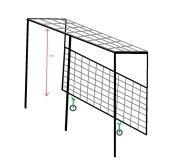Hi all,
We are on a small commercial vineyard (9ha), which I am slowly moving from conventional farming (lots of glyphosate and chemical controls), to a more wholistic operation. To be clear, this is not a hobby farm: the vines are my whole income and occupation. If the crop fails, the bills don't get paid.
That said, I am trying to shift as many of the vineyards controls as possible to animals: reducing the huge amount of mowing we do, and reducing chemical fertiliser and pest control. We will still need to spray against mildew and botrytis, but want to minimise it by having a good biologically active soil.
SHEEP:
So far, we have 13 sheep, and need a lot more. They are babydoll southdowns, and are working perfectly in single hotwire cell grazing arrangement. I estimate we need another 60 of them though! If anyone's interested, I can write a mini-article about how we're optimising the vineyard for the sheep.
PIGS:
We tried miniature pigs (Not true minis, as they are unavailable in Australia, but bred to only about 50cm at the shoulder). They really are lovely animals, but we simply cannot sustain the damage they cause. We only have 6, and we have found a new home for them starting this Saturday. We tried everything except noseringing, but when we recently caught them standing up with their front hoofs on the vine cordon eating our grapes, we knew we just can't keep them. Besides which, they turn a weeks worth of good grass into just mud within a day, and leave the ground so uneven we'll need to till it, which defeats the pupose. If we had a few more acres, I'd keep them, but we don't, so we can't.
Which brings me to our next animal experiment, and the reason for my post: poultry.
I don't want a repeat of the pig problem. I don't want to put poultry out there, just to find them sitting on the cordon mid season, eating our crop. A chicken tractor is out, because the main place we want them to hunt is directly under the trunks of the vines. So I'd use portable coops, shifted weekly, in rotation behind the sheep. We don't have a guardian dog, and they are incredibly hard to buy here, so I'll have to lock the birds up every night.
Does anyone have any experience with chickens in a substantial vineyard?
When the grapes are in season, will chickens damage the crop?
Chickens, ducks, geese? What poultry is least likely to get up into the cordon and eat grapes?
Honestly, I don't eat a lot of eggs, and we'll rarely slaughter a chicken. I'm solely interested in them for pasture/insect management.
Many thanks!
Jamie C.




